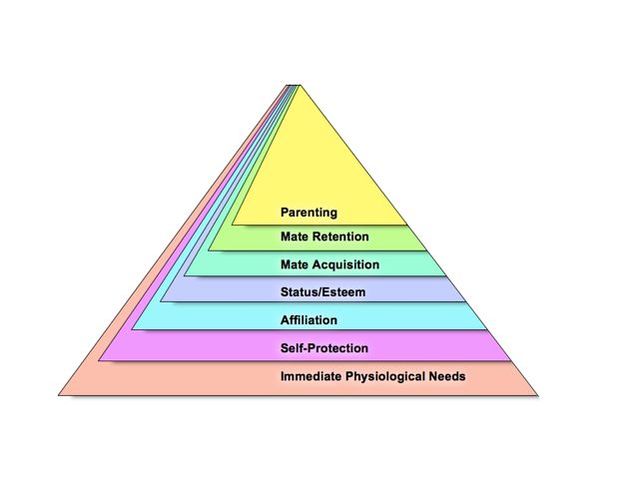Motivation
Rebuilding Maslow’s Pyramid on an Evolutionary Foundation
Modernizing Maslow with a multi-level evolutionary structure.
Posted May 20, 2010 Reviewed by Lybi Ma
If you’ve ever taken a general psychology course, you’ve seen Maslow’s pyramid of motives—it’s one of the field’s most vivid and memorable images. Maslow proposed a hierarchy of motives, with those at the bottom taking precedence over those higher up. If you are starving, for example, the basic physiological craving for food will trump all other goals and dominate your thought processes. Once you’re well-fed, you begin to worry about safety, once you’re safe you begin to worry about getting affection. At the top of Maslow’s pyramid was self-actualization—the desire to fulfill your unique creative potential (if you are a musician and you’ve satisfied all your lower biological needs, you can move on to playing music for its own sake; if you’re a poet, you can dedicate yourself to your poetry).
In some ways, Maslow’s ideas were brilliant, and later research and theory supported them. For example, Maslow was rebelling against the traditional behaviorist assumption that there were only a few primary motives (such as hunger and thirst, for example) and that all other motives were derived from those classical conditioning experiences. He argued that there were multiple independent motivational systems involved in seeking safety, the desire for love, and the need for esteem and that these were not directly connected to those basic physiological desires. Later research from neuroscience and evolutionary biology has supported this idea well.
Maslow also presumed that different motivational systems come at different phases of development. An infant is only concerned with basic physiological needs, and not with making friends. A kindergarten child begins to develop an interest in making friends and does not worry about gaining esteem until he cares about social opinions.
Maslow Revisited
But the modern integration of ideas from neuroscience, developmental biology, and evolutionary psychology suggests that Maslow had a few things wrong. For one thing, he never gave much thought to reproduction. He conceived of higher needs as completely personal strivings, unconnected from other people, and divorced from biological needs. Parental motivations were completely missing from his hierarchy, and he placed sexual needs down at the bottom—along with hunger and thirst. Presumably, sexual urges were biological annoyances that could be as well dispatched by masturbation as by having intercourse, before one moved back to higher pursuits like playing the guitar or writing poetry.
From a modern evolutionary perspective, that is a curious set of assumptions. For one thing, all living organisms, including you and I, inherited a set of motivational mechanisms that inspired us to reproduce. Like other mammals, humans also have strong attachments to the offspring they produce, and unlike most mammals, both sexes develop attachments to their mates and their offspring. In the renovated pyramid, reproductive goals are at the top, not the bottom. Furthermore, there is more than one independent set of motivations involved in reproduction. First, one needs to attract a mate. After that is accomplished, one needs to maintain a relationship (a very different set of problems, as some of us have learned). Finally, one needs to care for one’s offspring.

Some architectural changes
Self-actualization does not appear in the new pyramid, not because it’s not interesting and important, but because it is not fundamental. Research suggests that creative performances are hardly detached from other social motives—they are linked to gaining status and acquiring mates, especially for men (which is why men show off so much more than women, who are every bit as talented, but less ostentatious about it).
There are some other intellectually snazzy features of the renovated pyramid, which I’ll talk about later. For example, the new framework sorts out three important levels of analysis that were blurred or ignored by Maslow: evolutionary function, development, and proximate links between motives and the social environment. Importantly, the motives in the new pyramid are not stacked, as in Maslow’s pyramid. Instead, the new pyramid depicts later-developing goals as overlapping with, rather than completely replacing, earlier-developing goals.
For more information, see the original paper, which was published along with several commentaries by prominent research psychologists (several of whom, like John Bargh, Sonja Lyubomirsky, Chris Peterson, and Josh Ackerman, are, coincidentally, also bloggers for Psychology Today).
For some research that followed up on these ideas, check out the three links below.
References
Related posts:
Rate yourself on the new motivational pyramid. A new scale measures individual differences in fundamental motives.
How is self-actualization different from meaning in life?
Do you have to be self-centered to be self-actualized?
Ackerman, J.M., & Bargh, J.A. (2010). The purpose-driven life: Commentary on Kenrick et al. (2010). Perspectives on Psychological Science, 5, 323–326.
Kenrick, D.T., Griskevicius, V., Neuberg, S.L., & Schaller, M. (2010). Renovating the pyramid of needs: Contemporary extensions built upon ancient foundations. Perspectives on Psychological Science, 5, 292–314.
Kesebir, S., Graham, J., & Oishi, S. (2010). A theory of human needs should be human-centered, not animal-centered: Commentary on Kenrick et al. (2010). Perspectives on Psychological Science, 5, 315–319.
Lyubomirsky, S., & Boehm, J.K. (2010). Human motives, happiness, and the puzzle of parenthood: Commentary on Kenrick et al. (2010). Perspectives on Psychological Science, 5, 327–334.
Peterson, C., & Park, N. (2010). What happened to self-actualization? Commentary on Kenrick et al. (2010). Perspectives on Psychological Science, 5, 320–322.
Schaller, M., Neuberg, S.L., Griskevicius, V., & Kenrick, D.T. (2010). Pyramid power: Response to commentaries. Perspectives on Psychological Science, 5, 335-337.


